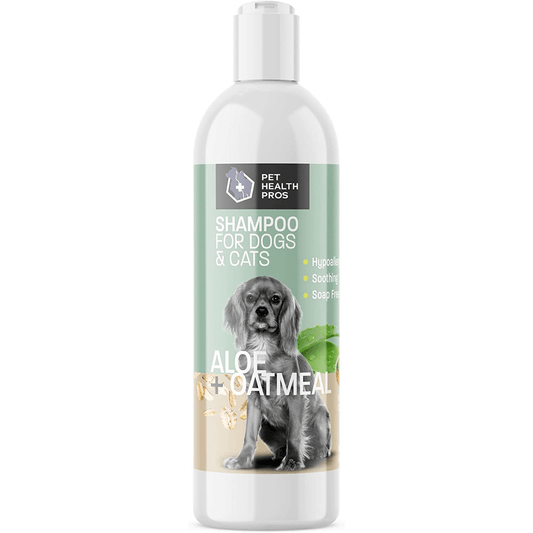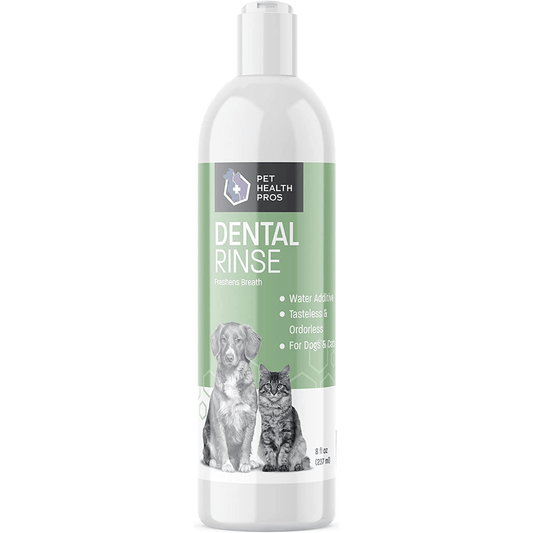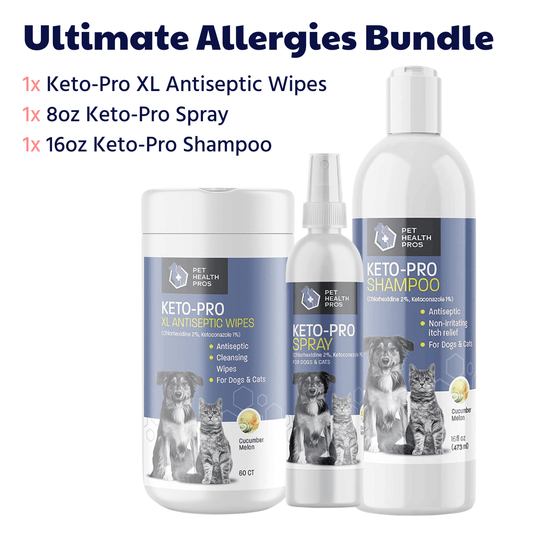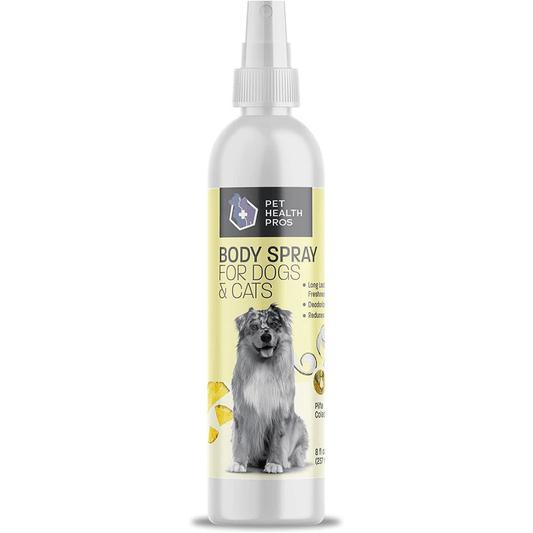If you're a dog owner, you know how important it is to keep your furry friend's ears healthy. Ear infections can be a common issue, and finding the right treatment, like the best ear drops for dogs, can make a huge difference. In this guide, we'll cover everything you need to know about ear infections in dogs, the types of ear drops available, and how to prevent these pesky problems from happening in the first place.
Key Takeaways
- Watch for signs of ear infections like shaking their head or scratching at their ears.
- Different types of ear drops serve various purposes, including antibiotics and cleaning solutions.
- Look for ear drops with safe and effective ingredients for your dog's health.
- Administering ear drops can be tricky; preparation and patience are key.
- Regular ear cleaning can help prevent infections and keep your dog's ears healthy.
Understanding Ear Infections in Dogs
Ear infections are a pretty common problem for our canine friends. It's something most dog owners will deal with at some point. Knowing what to look for and what causes these infections can really help you keep your dog happy and healthy. I've had my fair share of vet visits for ear issues with my own pups, so I get how important it is to stay informed.
Common Symptoms of Ear Infections
Okay, so how do you know if your dog has an ear infection? Well, there are a few telltale signs. One of the most obvious is excessive scratching or rubbing at the ears. You might also notice your dog shaking their head a lot. Other symptoms include:
- Redness inside the ear canal
- A bad smell coming from the ear
- Discharge (which can be yellow, brown, or even bloody)
- Swelling
- Pain when you touch their ears
If you see any of these, it's a good idea to take a closer look and maybe give your vet a call. Ignoring it can make things worse, trust me.
Causes of Ear Infections
So, what causes these pesky ear infections anyway? Several things can contribute, but here are some of the most common:
- Bacteria: These are often secondary invaders, taking advantage of an already irritated ear.
- Yeast: Malassezia is a common culprit, especially in dogs with allergies.
- Allergies: Food or environmental allergies can cause inflammation in the ears, making them more prone to infection.
- Moisture: Dogs who swim a lot or have floppy ears that trap moisture are at higher risk.
- Ear mites: These tiny parasites are more common in puppies but can affect dogs of any age.
- Foreign bodies: Grass seeds or other debris can get stuck in the ear canal and cause irritation and infection.
It's worth noting that some dogs are just more prone to ear infections than others. Breeds with long, floppy ears, like Cocker Spaniels and Basset Hounds, tend to have more problems because their ears don't get as much air circulation.
When to Consult a Veterinarian
Alright, so you've noticed some symptoms, now what? While some minor irritations might clear up on their own, it's usually best to see a vet if you suspect an ear infection. Here's when you should definitely make an appointment:
- If it's the first time your dog has had an ear infection.
- If the symptoms are severe (lots of pain, bleeding, etc.).
- If the infection doesn't seem to be improving after a few days of home treatment.
- If your dog has a history of chronic ear infections.
A vet can properly diagnose the cause of the infection and prescribe the right medication. Plus, they can clean the ear thoroughly and make sure there aren't any underlying issues. Don't try to play doctor – it's better to be safe than sorry!
Types of Ear Drops for Dogs
Alright, so your vet says your dog needs ear drops. But did you know there are different kinds? It's not just one-size-fits-all. Let's break down the main types you might encounter.
Antibiotic Ear Drops
These are the big guns when it comes to bacterial infections. If your dog's ear infection is caused by bacteria, your vet will likely prescribe antibiotic ear drops. They work by killing the bacteria causing the problem. It's super important to finish the entire course of treatment, even if your dog's ear looks better after a few days. Otherwise, the infection could come back, and the bacteria might become resistant to the antibiotic.
Anti-Inflammatory Ear Drops
Inflammation is a common side effect of ear infections, causing redness, swelling, and discomfort. Anti-inflammatory ear drops, often containing corticosteroids, help reduce these symptoms. They don't treat the underlying infection but make your dog more comfortable while the other medications do their job. Sometimes, these drops are combined with antibiotics or antifungals in a single product.
Cleaning Solutions for Dog Ears
These aren't technically "ear drops" in the medicinal sense, but they're a crucial part of ear care. Cleaning solutions help remove wax, debris, and discharge from the ear canal, creating a cleaner environment for medications to work. They can also be used for regular ear cleaning to prevent infections in the first place.
It's important to use a cleaning solution specifically designed for dogs, as human products can be too harsh and cause irritation. Also, never insert anything deep into your dog's ear canal – just clean the parts you can easily see.
Here's a quick rundown of what to keep in mind:
- Antibiotic Drops: For bacterial infections; complete the full course.
- Anti-Inflammatory Drops: Reduce swelling and discomfort; often used with other meds.
- Cleaning Solutions: Remove debris and prevent infections; use dog-specific products.
Key Ingredients to Look For
Choosing the right ear drops for your dog can feel like decoding a secret formula. It's not just about grabbing the first bottle you see; it's about understanding what ingredients will actually help your furry friend. Let's break down the key components you should be aware of when selecting ear drops.
Active Ingredients in Ear Drops
The active ingredients are the powerhouses that directly combat the infection or inflammation. These are the components that do the heavy lifting. Common ones include:
- Antibiotics: These fight bacterial infections. Examples include gentamicin, enrofloxacin, and neomycin. If your vet suspects a bacterial infection, they'll likely prescribe drops with one of these.
- Antifungals: These target yeast infections, another common culprit behind ear issues. Look for ingredients like miconazole or clotrimazole.
- Corticosteroids: These reduce inflammation and itching. Hydrocortisone and dexamethasone are common examples. They can provide quick relief but don't address the underlying infection.
- Parasiticides: Some ear drops include ingredients to kill ear mites, such as pyrethrins or ivermectin. These are essential if mites are the cause of the problem.
Natural vs. Synthetic Ingredients
There's a growing interest in natural remedies, and ear drops are no exception. Some products boast natural ingredients like aloe vera, tea tree oil, or witch hazel. While these can have soothing or antiseptic properties, it's important to consider a few things:
- Effectiveness: Natural ingredients might not be as potent as synthetic antibiotics or antifungals for severe infections.
- Allergies: Dogs can be allergic to natural substances just like they can be allergic to synthetic ones. Always test a small amount first.
- Concentration: The concentration of the active compound in natural products can vary, making it harder to ensure consistent results.
It's always a good idea to chat with your vet before switching to a natural remedy, especially if your dog has a known infection. They can help you weigh the pros and cons and make sure it's a safe and effective choice.
Safety Considerations for Ingredients
Safety should always be a top priority. Some ingredients, while effective, can have potential side effects. Here's what to keep in mind:
- Ototoxicity: Some antibiotics, like gentamicin and neomycin, can be ototoxic, meaning they can damage the inner ear and potentially cause hearing loss. This is more of a concern if the eardrum is ruptured, so your vet will need to check that first.
- Allergic Reactions: Watch for signs of an allergic reaction, such as increased redness, swelling, or itching after applying the drops.
- Drug Interactions: If your dog is on other medications, check with your vet to make sure the ear drop ingredients won't interact negatively.
Choosing the right ear drops involves a bit of research and a conversation with your vet. By understanding the active ingredients, weighing the pros and cons of natural versus synthetic options, and considering safety, you can help your dog get the relief they need.
How to Administer Ear Drops to Your Dog
Alright, so you've got the ear drops, and you're ready to help your furry friend feel better. Administering ear drops can be a bit tricky, but with a little patience and the right approach, you can make the process as smooth as possible for both of you. It's all about being prepared and staying calm.
Preparing Your Dog for Treatment
First things first, get everything ready. Gather the ear drops, some cotton balls, and maybe a towel. Choose a quiet spot where your dog feels comfortable. Positive reinforcement is key; have some treats on hand to reward your dog for good behavior. A calm environment makes a huge difference. If your dog is super anxious, try taking them for a short walk beforehand to burn off some energy. Also, make sure you understand the dosage and instructions on the ear drop bottle. It's always good to be prepared.
Step-by-Step Guide to Administering Drops
Okay, here's the breakdown:
- Positioning: Have your dog sit or lie down. If you have a small dog, you might want to hold them in your lap. For larger dogs, kneeling beside them often works best.
- Ear Prep: Gently pull back the ear flap to expose the ear canal. If there's a lot of wax or debris, use a cotton ball to carefully wipe it away. Don't go too deep!
- Application: Hold the ear drop bottle tip above the ear canal and squeeze the prescribed amount of drops into the ear. Avoid touching the ear with the bottle tip to prevent contamination.
- Massage: Gently massage the base of the ear for about 30 seconds to help the drops work their way down into the canal. You should hear a squishing sound.
- Clean Up: Let your dog shake their head (they're gonna do it anyway!). Use a clean cotton ball to wipe away any excess liquid and debris that comes out.
Tips for Easing Your Dog's Discomfort
- Speak in a soothing voice throughout the process. Your calmness can help keep your dog calm.
- Give treats and praise after each step to create a positive association with the treatment.
- If your dog is really resistant, try breaking the process into smaller steps over a few minutes. Don't force it; that will only make things worse.
- Warm the ear drop bottle in your hand for a few minutes before applying. Cold drops can be uncomfortable.
Remember, every dog is different. Some dogs are super chill about getting ear drops, while others act like you're trying to end the world. Be patient, and don't get discouraged if it takes a few tries to get it right. If you're really struggling, ask your vet for a demonstration. They've seen it all before!
And if you're looking for the right product, make sure to check out the best ear drops for your dog.
Top Recommendations for the Best Ear Drops for Dogs
Choosing the right ear drops for your dog can feel overwhelming, but don't worry, I'm here to help. It's important to remember that what works wonders for one dog might not be the best choice for another. Always consult with your vet before starting any new treatment. They can give you the best advice based on your dog's specific needs.
Popular Brands and Their Features
Okay, let's talk brands. There are a few names that pop up often when you're looking for dog ear drops. Zymox is a popular choice, known for its enzyme-based formula that can be effective against a range of infections. Then there's Virbac Epi-Otic, which is more of a cleaning solution but is great for maintenance and prevention. Finally, consider Claro; it's a vet-administered option that provides a longer-lasting treatment, which is super convenient. Each brand has its own strengths, so it really depends on what you're trying to tackle.
Comparative Analysis of Effectiveness
So, how do these ear drops stack up against each other? Well, it's not always a straightforward comparison. Effectiveness can depend on the type of infection, how severe it is, and even your dog's individual response. For example, Zymox is often praised for its gentle yet effective approach, especially for yeast infections. Epi-Otic is excellent for removing debris and wax, which can help prevent infections from starting. Claro, because it's administered by a vet and lasts longer, can be a good option for dogs that are difficult to treat at home. Here's a simple comparison table:
| Brand | Key Features | Best For |
|---|---|---|
| Zymox | Enzyme-based, gentle | Yeast infections, general infections |
| Virbac Epi-Otic | Cleaning, drying | Prevention, wax removal |
| Claro | Long-lasting, vet-administered | Severe infections, difficult-to-treat dogs |
User Reviews and Ratings
What are other dog owners saying? User reviews can be a goldmine of information. You'll often find that people rave about Zymox for its ability to clear up chronic ear issues. Epi-Otic gets high marks for being a reliable cleaner that doesn't irritate sensitive ears. Claro reviews often highlight the convenience factor, but some owners mention the cost as a potential downside. It's always a good idea to read a range of reviews to get a well-rounded picture. Keep in mind that every dog is different, so what works for one might not work for another.
Ultimately, the best ear drops for your dog will depend on their specific condition and needs. Talk to your vet, do your research, and pay attention to how your dog responds to the treatment. With a little patience and the right approach, you can help your furry friend find relief from ear infections.
Preventing Ear Infections in Dogs
Regular Ear Cleaning Practices
Okay, so, keeping your dog's ears clean is a big deal. It's not just about making them look nice; it's about preventing those nasty ear infections. Regular cleaning helps remove wax and debris that can create a breeding ground for bacteria and yeast.
- Use a vet-approved ear cleaning solution. Seriously, don't just grab anything off the shelf.
- Clean after swimming or bathing. Water trapped in the ear canal? Bad news.
- Make it a routine. Once a week is a good starting point, but some dogs might need it more often.
I've found that making ear cleaning part of our regular grooming routine really helps. My dog used to hate it, but now he just tolerates it, which is a win in my book. It's all about consistency and positive reinforcement – lots of treats!
Signs of Ear Problems to Watch For
Knowing what to look for can save you a lot of trouble. If you catch an ear infection early, it's way easier to deal with. Keep an eye out for these signs.
- Excessive scratching or head shaking. This is usually the first clue.
- Redness or swelling in the ear canal. Get in there and take a peek.
- Discharge or odor. Anything that smells funky or looks unusual is a red flag.
Lifestyle Changes to Reduce Risk
Believe it or not, some lifestyle tweaks can make a difference. It's not just about cleaning; it's about creating an environment that's less likely to cause problems.
- Keep your dog's ears dry. After swimming, use a cotton ball to soak up any water.
- Consider their diet. Some dogs have allergies that can contribute to ear infections.
- Grooming matters. If your dog has long hair around their ears, keep it trimmed to improve airflow.
Consulting Your Veterinarian
It's easy to try to handle your dog's ear issues yourself, especially with so many over-the-counter options available. But sometimes, you just need a vet's opinion. Knowing when to seek professional help can save your dog from unnecessary discomfort and prevent more serious problems down the road.
When to Seek Professional Help
Don't wait if you notice any of these signs. Early intervention is key to preventing complications.
- Severe pain: If your dog is constantly pawing at their ear, shaking their head violently, or yelping when you touch their ear, it's time to call the vet.
- Discharge: Any unusual discharge, especially if it's bloody, smelly, or pus-like, needs immediate attention.
- Neurological signs: Head tilting, loss of balance, or circling can indicate a more serious infection that has spread to the inner ear or brain.
- Ineffective home treatment: If you've been using over-the-counter ear drops for a few days and see no improvement, it's time to consult a professional.
What to Expect During a Vet Visit
So, you've made the appointment. What happens next? Your vet will likely start with a thorough physical exam, paying close attention to your dog's ears. They'll use an otoscope to look deep into the ear canal, checking for inflammation, discharge, and any foreign objects.
Here's what else might happen:
- Sample collection: The vet might take a sample of the ear discharge to examine under a microscope. This helps identify the type of infection (bacteria, yeast, or mites) and determine the best course of treatment.
- Ear cleaning: The vet may perform a professional ear cleaning to remove debris and wax buildup, which can interfere with the effectiveness of medication.
- Discussion of treatment options: Based on the diagnosis, the vet will discuss the best treatment plan for your dog. This might include prescription ear drops, oral medications, or other therapies.
Follow-Up Care After Treatment
Getting your dog's ears back to normal doesn't end with the vet visit. Follow-up care is super important to make sure the infection is completely gone and doesn't come back.
Here's what you should do:
- Administer medication as directed: Follow the vet's instructions carefully and complete the entire course of medication, even if your dog seems better.
- Schedule follow-up appointments: Your vet may want to see your dog again in a week or two to check on their progress and make sure the infection is clearing up.
- Maintain regular ear cleaning: Once the infection is gone, establish a regular ear cleaning routine to prevent future problems. Your vet can recommend the best cleaning solution and technique for your dog.
Remember, being proactive about your dog's ear health is the best way to keep them happy and comfortable. Don't hesitate to seek professional help if you're concerned about their ears. A quick trip to the vet can make all the difference.
When it comes to your pet's health, talking to your veterinarian is really important. They can help you understand any issues your pet might have and give you the best advice. If you have questions or need more information, don’t hesitate to reach out to us through our website. We’re here to help you and your furry friend!
Final Thoughts on Choosing Ear Drops for Your Dog
In conclusion, picking the right ear drops for your dog is really important for their health and comfort. You’ve got to consider the specific needs of your pup, whether they’re dealing with infections, allergies, or just some wax buildup. Always check with your vet before trying something new, as they can guide you to the best option. Remember, what works for one dog might not work for another, so don’t hesitate to try different products if needed. Keeping your dog’s ears clean and healthy can make a big difference in their overall well-being.
Frequently Asked Questions
What are common signs that my dog has an ear infection?
Look for signs like shaking their head, scratching their ears, bad smell from the ears, or redness inside the ear.
What causes ear infections in dogs?
Ear infections can be caused by allergies, moisture in the ears, or foreign objects getting stuck.
When should I take my dog to the vet for ear issues?
If you notice any signs of an ear infection or if your dog seems in pain, it's best to see a vet right away.
What types of ear drops are safe for dogs?
There are antibiotic drops, anti-inflammatory drops, and cleaning solutions specifically made for dogs.
How do I properly put ear drops in my dog's ears?
Make sure your dog is calm, hold their head steady, and follow the instructions on the ear drop bottle for how much to use.
How can I prevent ear infections in my dog?
Regularly clean your dog's ears, keep them dry, and check for any signs of problems to catch issues early.








